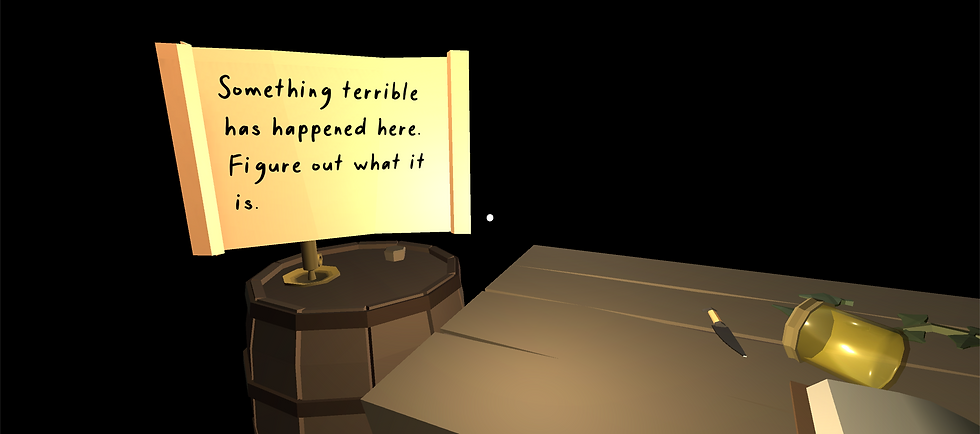Medieval Detective VR
- Katherine Byers

- Jun 17, 2020
- 3 min read
Updated: Mar 7, 2021
Download link: https://mmgerik.itch.io/medieval-detective-vr
You open your eyes to darkness. In front of you lies a cryptic, unsigned note. Follow the hints of your strange benefactor to uncover the mystery of what happened in this room before you arrived. Medieval Detective is a hidden objects VR game created for the Google Cardboard.
We were originally going to build a dungeon crawler-esque game for the HTC Vive, but due to complications from COVID-19 we had to downscale to a Google cardboard. As a result, we retooled the idea into the hidden objects game we created. We may not be able to make the dungeon epic we had wanted, but we will do our best to maximize the capabilities of the Cardboard and work to create a fun and interesting experience that players will enjoy regardless. The gameplay is mostly gaze based, as the button on the Cardboard is unreliable and honestly not user friendly. The player will look at an object for a certain period of time (~2 sec) in order to collect the item and reveal a new portion of the room and a new clue.

I primarily worked on the gaze based scripting, as well as the "Story line" class that held all the voice over lines, their respective clues/hints, and the next hint to display. Each voice over "hint" is played after waiting for ~3-5 seconds while the player is trying to find the object. These could be changed in the editor, and it made the process a lot easier for our world builder. I used a dictionary to tie the story line class and object to each other, in an attempt to allow the player to go in whichever order they wanted, but in the end it didn't quite work out that way. If I were to redo that portion, I would either get rid of the dictionary/class entirely, or use a list instead and overhaul the story line class. The whole experience was rather linear in total, because with each new object found, more of the room came into view. Thus, the need for the player to be allowed to go out of order is unneeded since they can't do so. However, it's still used in the game as it is now, as it also hold the coroutines to play the hints related to each item (if the player cannot figure it out via the written hint), and the system for the hints to appear on the paper following the player around.
The gaze based scripting took advantage the Google SDK, and a wonderful tutorial our professor provided us in order to set it up correctly. It detects when an object is being looked at in order to start counting down a timer, and once that timer has finished, an action will happen based on what the player is gazing at. If the player is looking at a teleportation pad on the ground, the will move to that position, and if a player is looking at an object that's supposed to be found, a particle effect will trigger and the next clue will appear. If a player looks at an object that is neither of those two, nothing will happen.

We struggled a lot with trying to optimize our code/build, since a lot of the camera tricks my teammate worked on pulled a lot away from the phone, and the room itself caused some lag which can severely mess up an experience in VR. We had to adjust the number of objects in the room, how light worked in the scene, how the camera showed new areas of the room, and monitor how many particles were being shown in scene at any given time.

This is easily the largest game I've created in my time at UT, and we spent around a month creating it. I was lucky to work with such a talented group, and one that worked so well together. We had wonderful communication with each other, even when other classes took all our attention. Oddly enough, the hardest part of the process was trying to come up with riddles for the player to solve, and they likely still need to be retooled but it seemed like players were able to understand (most) of them, which I will consider a success. On the itch.io page there's also a link to our development blog which has more information on what the other members contributed to the process as well as a few more details overall.
We submitted this game to the AET (Art and Entertainment Technology) Student Showcase, however we have not heard a response regarding this.







Comments